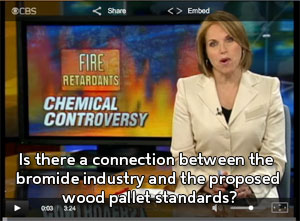In the end, however, local fire marshals must interpret the codes, and the NASFM Bulletin was the organization’s view on how those existing pallet codes should be interpreted – in this case, that many facilities using most wood or wood composite pallets would need higher grade sprinkler systems.
NASFM has said that driving that changing interpretation in part was that existing standards are based on the original oak stringer pallet going back decades, while today many different types of wood are used, including composite materials that contain binding agents. Adhesives are also used to connect composite wood blocks to the boards. NASFM originally interpreted those changes as meaning existing standards did not address the enhanced risk that these pallets had versus the oak stringer pallets.
The good news coming out of the meeting is that NASFM now seems to recognize that “wood is wood,” according to Scholnick. In other words, standards for wood pallets regardless of “species” of wood used do not need to be treated differently. What the view will be on composites in the end is less clear.
NASFM has said it will work with industry groups and code makers to refine the Bulletin by June 1, 2009. There is strong hope now that this refined document will not have a big impact on most shippers, according to Scholnick – but there are no guarantees.
In addition to a wide variety of companies involved in wood pallet manufacturing or distribution, a number of large shippers were also in attendance at the NASFM meeting, including Kroger, Nestle and Kraft.
Scholnick said the NASFM officials did not seem to very well understand how pallets are used in the supply chain (e.g., cross company use) and the variation in wood pallets and how they are re-used many times until their end-of-life.
“That was a bit of an eye opener to them,” he said.
 Is Process Suspect? Is Process Suspect?
The pallet interpretation was actually the first such Bulletin the NASFM had ever issued. According to Scholnick, the process seemed to have been “fast tracked,” – odd given the huge financial impact the recommendations could have potentially had on shippers.
In fact, Scholnick said he was first made aware of the issue by retailer Costco.
NASFM put the Bulletin on its site with little contact with the industry, took public commentary for a relatively short period of time, and then was prepared to issue the final Bulletin before industry uproar caused NASFM to hold the public meeting two weeks ago.
Why would NASFM pick this issue for its first Bulletin, and seem to fast track the process?
No one knows for sure, but in May of 2008, CBS News did a report on the lobbying efforts of the bromide industry. Bromides are a class of chemicals that can be used as flame retardants – though there are also strong safety concerns about the chemical, which has been banned in two states and is being looked at by quite a few more.
It turns out tha, at least at that time, a key lobbyist for the bromide industry was also a lobbyist for NASFM. (Why it needs a lobbyist at all is not clear).
So what does this have to do with pallets? Plastic pallets, obviously an alternative to wood, can contain bromides as a flame retardant. So, if sprinkler standards were raised on wood or wood composite pallets, but not on plastics pallets with flame retardants, that would be good for the bromide industry.
The CBS video report can be found here: A Ban on Fire Retardants?
Just a coincidence? Not clear, but the connections certainly do lead to questions.
SCDigest and Distribution Digest will keep on top of this very interesting story.
Did you even know about this potential change in pallet classifications and fire codes? What would you do if this eventually did become a “best practice” for local fire marshals? Does the process seem fishy to you? Let us know your thoughts at the Feedback button below.
|